
- Home
- Travel Packages
- Top Destination
-
Travel Attraction
By Category
Top Attraction

- Travel Agents
- Car Rentals
- Hotels
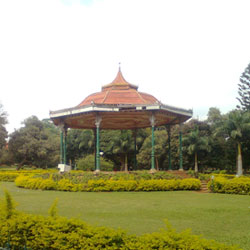
The Lal Bagh Botanical Gardens, laid out by Hyder Ali is located on the southern fringes of the city. It holds a number of flower shows, especially during the Republic Day (26th January). They have over 1000 species of flora. The Glass House, modeled on London's Crystal Palace, is the center of attraction. Hyder Ali laid out these famous botanical gardens and his son added horticultural wealth to them by importing trees and plants from several countries. This is a beautiful 2400-acre park. Of all the good that Hyder Ali and Tipu Sultan did, this must be the best. The Lalbagh Gardens were commissioned by the 18th century and over the years it acquired India first lawn-clock and the subcontinent largest collection of rare plants. The garden also has trees that are over 100 years old.
Explore More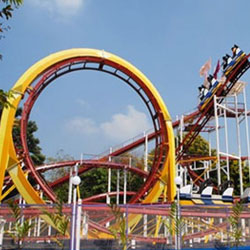
Essel World, the first and foremost amusement park is located on Gorai Island on 64 acres of green lands. It offers thrilling and scintillating rides and games. Essel World offers over 40 exciting rides, games, and attractions. The Water Kingdom is said to be the largest of its kind in Asia. This international-style theme park and amusement centre situated close to Gorai Beach is perfect for a one-day holiday. Special ferries get you across to the park and the entrance fee normally takes care of a fixed number of rides, which include the standard roller coaster and adventure themes, plus a water world section where kids can literally run amok. Summer is usually crowded, but the place also offers low budget monsoon packages and special deals on weekends.
Explore More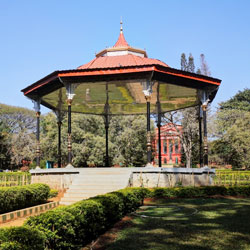
Laid out by Lieutenant General Sir Mark Cubbon this park is located near the Vidhan Soudha and has a number of neo-classical styled government buildings. Over 250 acres of this green park is a joggers and walkers delight. This wooded and be flowered park was laid out by Lord Cubbon, the then viceroy of India in the heart of the cantonment in 1864. Since then fairy fountains and an august bandstand have been added. But the most important aspect of Cubbon Park is its newer buildings that have brought it cultural wealth. No one would be surprised if one refers Bangalore as the garden city of India after have a walk at the Cubbon Park. On a grassy expanse in the centre of Bangalore is this park, planned and laid out by Sir Richard Sankey, the then Chief Engineer of Mysore. It is named after Sir Mark Cubbon, Bangalore's longest serving Commissioner. These are acres of land dedicated to trees, flowerbeds and rolling lawns: which means Cubbon Park has got its fair share of monuments: red-faced government buildings that house the Public Library, the Government Museum and the High Court.
Explore More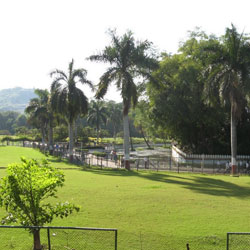
With pleasant lawns and the famous Ganesh temple built by Madhavrao Peshwa, Saras Baug is a popular evening spot in Pune. An exquisitely landscaped place with excellent well manicured lawns and well lit fountains, a recourse where one can relax especially during the evenings. Evening is the also the best time to visit this garden and have a taste of the cuisine available at the food stalls nearby if one gets hungry.
Explore More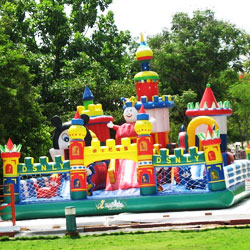
It is India's No. 1 Theme Park located about 28 Kms. south of Chennai at Tambaram. The attractions represent a wonderful blend of tomorrow's technology and all-time fantasies. Some hi-tech and exciting rides and attractions here, are space shuttle, wave pool, white water, flame ride and Kiddies Kingdom. Navodaya Mass Entertainment opened the amusement park. Navodaya is the seat of such rare talents and experimentation and research for excellence is the main pre-occupation.
Explore More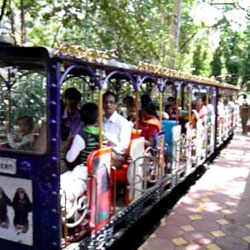
Bal Bhavan in Bangalore is a great amusement park and recreation centre. The place consists of small toy train inside the Cubbon Park that covers almost 3/4th miles of it, a Dolls Museum, a 20 million year old fossilized tree, boating facility, a fair ground and children’s park. The park is a favorite with kids as it has swings, tree houses and horse rides. Bal Bhavan is a great place for children as it hosts a lot of hobby classes comprising of painting, arts and crafts. The Vijayaranga Theatre located in Bal Bhavan is an attraction for children as many film shows and theater performances are conducted there. The place is a great attraction for kids.
Explore More
Zoological Gardens is situated at Alipore Road, the horticultural garden houses the Zoo of Calcutta, with many wild animals in natural enclosures. It also has many varieties of birds and reptiles other than the interesting flora and fauna. To the south of the Maidan, Calcutta 16-hectare zoo was opened in 1875.Some of the animals are displayed in near natural environments, others in the pitiful conditions characteristic of Third World zoos. In 1873, the then Governor Sir Richard Temple proposed the formation of a zoo in Calcutta. Sir C.L. Lendal corroborated it. Finally, the Government allotted land for this purpose responding to the joint petition of The Asiatic Society and Agri-Horticultural Society. This is the largest zoo in India. It comprises several animals, birds and even creatures of rare species. It has a large collection of birds and mammals, and an enclosure for reptiles, including a tortoise that is much older than the zoo itself. During the winter season, the migratory birds flock in the zoo for its artificial lake and vegetation. Directly across the main zoo is an aquarium, with a variety of aquatic life from around the world.The Zoological Gardens, was established as a private, voluntary society. It is famous for its tigers. Special attractions are the white tiger, the tigon (a cross between a tiger and a lion) and the litigon (a cross between a lion and a tigon). It can take hours to go through all the sections. The campus also features a children's park and a cafeteria.
Explore More
The Malabar hill offers superb views of Mumbai. On top of the Malabar hills are the Hanging gardens and Kamala Nehru Park. Named after the wife of India's first Prime Minister Jawaharlal Nehru, from here one enjoys a magnificent view of Marine Drive, 'Queen's Necklace'. The park has a decent children's playground and the constant source of enjoyment is the gigantic 'Old Lady's Shoe' meant for children to play in.From the top of the shoe one can survey the entire garden. Another feature here is the lovely pavilion, which is surrounded by beautiful flowers and huge lawns. There is also a map of the city engraved in copper.
Explore More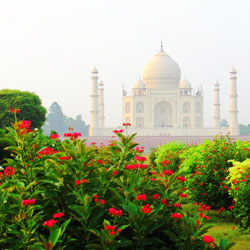
Introduction to Mehtab Bagh, Agra : The Mehtab Bagh in Agra is laid out in just right symmetry and alignment with the Taj Mahal and it was intentionally built as an integral part of the original design of the Taj Mahal during the period from 1631 to 1635 A.D.
Explore More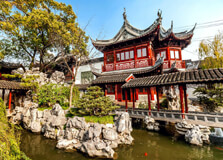
Located in the heart of Shanghai’s Old City, Yu Garden (Yuyuan Garden) is one of the most iconic classical Chinese gardens in the city. Known for its beautiful landscapes, traditional architecture, and peaceful ambiance, the garden offers visitors a glimpse into the rich cultural heritage of Shanghai. Spanning over 20,000 square meters, Yu Garden is a perfect blend of nature and art, showcasing ancient Chinese landscaping techniques, pavilions, ponds, rockeries, and bridges that date back to the Ming Dynasty. It is one of the best places to experience the tranquility of a traditional Chinese garden amidst the hustle and bustle of modern Shanghai. How to Reach Yu Garden, Shanghai Yu Garden is centrally located in the Old City area of Shanghai, making it easily accessible by public transport. Here’s how you can reach Yu Garden: By Metro: The nearest metro station is Yuyuan Garden Station, which is served by Line 10. It is just a short walk from the station to the garden entrance. The metro is one of the most convenient ways to reach the garden from other parts of the city. By Bus: Several bus routes pass through the Old City area, including Bus 930, 42, and 926. Look for stops near Yuyuan Garden or the City God Temple, which is located nearby. By Taxi: Taxis are easily available throughout the city. If you’re taking a taxi, simply tell the driver you want to go to Yu Garden or Yuyuan Garden, and they will know the way. Weather in Shanghai Shanghai has a humid subtropical climate, which means the weather can vary depending on the season. Here’s what you can expect when visiting Yu Garden: Spring (March to May): Spring is a pleasant time to visit, with temperatures ranging from 10°C to 20°C (50°F to 68°F). The weather is mild, and flowers begin to bloom, adding to the beauty of the garden. Summer (June to August): Summer in Shanghai is hot and humid, with temperatures often exceeding 30°C (86°F). This is also the rainy season, so it’s a good idea to bring an umbrella. Despite the heat, the garden offers plenty of shade and is still a great place to visit. Autumn (September to November): Autumn offers cooler and more comfortable weather, with temperatures between 15°C to 25°C (59°F to 77°F). The pleasant weather makes it an ideal time to explore the garden. Winter (December to February): Winter in Shanghai can be cold and damp, with temperatures ranging from 0°C to 8°C (32°F to 46°F). It rarely snows, but the chill can make walking around the garden a bit uncomfortable, so be sure to dress warmly. Timing to Visit Yu Garden, Shanghai The Yu Garden is open every day of the year, and its timing is consistent throughout the year. Here’s the schedule: Opening Hours: The garden is open daily from 8:30 AM to 5:30 PM, with the last entry at 5:00 PM. The garden can get busy, especially during weekends and holidays, so visiting earlier in the day is recommended to avoid large crowds. Best Time to Visit: For a more peaceful experience, it’s best to visit early in the morning or on weekdays when there are fewer visitors. The garden is particularly beautiful during spring and autumn when the flowers and trees are in full bloom or vibrant fall colors. Why Famous for Yu Garden, Shanghai? Yu Garden is famous for its stunning classical Chinese garden design and its historical significance. Here are a few reasons why it is one of the must-visit attractions in Shanghai: Historical Significance: The garden was originally built during the Ming Dynasty in 1559 by the wealthy official Pan Yunduan as a private garden for his family. It has since become a symbol of traditional Chinese landscaping and a cultural heritage site. Exquisite Landscaping: Yu Garden is known for its beautiful landscaping, including rockeries, ponds, pavilions, bridges, and ancient trees. The garden’s design follows the principles of Chinese feng shui and traditional garden aesthetics, creating a harmonious and tranquil environment. Architectural Beauty: The garden features traditional Chinese architecture, with ornate roofs, intricate carvings, and delicate decorations. The buildings blend seamlessly with the natural surroundings, providing a perfect representation of classical Chinese design. Cultural Importance: The garden is an essential part of Shanghai’s cultural identity and offers visitors a chance to experience the traditional beauty of Chinese gardens. It reflects the classical Chinese garden's philosophy of harmony between man, nature, and architecture. Entry and Visit Details about Yu Garden, Shanghai Visiting Yu Garden is an enriching experience, and there are a few details to know before you go: Admission: The standard entrance fee for Yu Garden is around 40 RMB per person. However, during peak times or special events, the ticket price may vary. Children, senior citizens, and students may be eligible for discounted entry. Facilities: The garden has various facilities for visitors, including rest areas, souvenir shops, and restaurants. You can buy souvenirs such as Chinese tea, artwork, and other traditional crafts. Accessibility: Yu Garden is accessible to people with disabilities, though there may be some areas that are difficult to navigate due to the garden's design, which features lots of steps and uneven paths. The main walkways and pavilions are wheelchair-friendly. History and Architecture of Yu Garden Yu Garden was constructed in 1559 by Pan Yunduan, an official of the Ming Dynasty, as a private garden for his family. Over the centuries, the garden has gone through several phases of restoration and preservation, especially after it was severely damaged during the Taiping Rebellion in the 19th century. The garden was eventually opened to the public in 1961 and has since become one of Shanghai’s most popular tourist destinations. Architecturally, Yu Garden is a prime example of classical Chinese garden design. The layout follows the traditional principles of feng shui, which aims to create harmony between humans and nature. The garden is divided into several sections, each with its own unique theme, including the Grand Rockery, the Hall of Spring, and the Lotus Pond. Traditional Chinese architectural elements such as curved roofs, wooden beams, and intricately carved windows are used throughout the garden’s pavilions and bridges, offering a stunning visual experience for visitors. Things to Do at Yu Garden Yu Garden offers a variety of things to do, from simply enjoying the peaceful surroundings to exploring the historical buildings and nearby attractions: Stroll Through the Gardens: Take a leisurely walk through the garden’s winding paths and discover its many scenic spots, such as the Lotus Pond and the Grand Rockery. Admire the Architecture: The garden features many beautiful pavilions, bridges, and halls, showcasing traditional Chinese architecture. Be sure to stop and admire the intricate details of the carvings and roof designs. Explore the Bazaar: Just outside the garden entrance is the Yuyuan Bazaar, a bustling market where you can shop for Chinese souvenirs, snacks, and traditional crafts. Visit the Teahouse: Stop by the traditional teahouse within the garden and enjoy a cup of Chinese tea while enjoying the beautiful surroundings. Facts About Yu Garden Yu Garden was built in 1559 during the Ming Dynasty by Pan Yunduan, a wealthy official. The garden covers an area of over 20,000 square meters and is divided into six main scenic areas. Yu Garden is a prime example of classical Chinese garden design, with a focus on harmony between architecture, nature, and water features. The garden has been open to the public since 1961 and is now one of Shanghai’s most popular tourist attractions. Tips for Visiting Yu Garden Arrive Early: To avoid crowds, it’s best to visit the garden early in the morning when it’s less crowded. Wear Comfortable Shoes: There are many steps and uneven paths throughout the garden, so comfortable footwear is recommended. Take Your Time: The garden is a peaceful place, so take your time to explore its many beautiful corners and enjoy the serene atmosphere. Bring an Umbrella: If you’re visiting during the summer, bring an umbrella to shield yourself from the sun or potential rain.
Explore More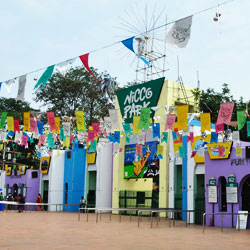
Nicco Park – Kolkata’s Premier Family Amusement Destination Spread across 40 acres in Sector IV, Salt Lake City (Bidhannagar), Nicco Park stands out as one of Eastern India’s most beloved theme parks. Launched on 13 October 1991, this "Disneyland of West Bengal" offers a perfect mix of thrill, family fun, and educational experiences Opening Hours Main Park: 10:30 AM – 6:45 PM (gates), 10:45 AM – 7:30 PM (rides) Food Court: Opens at 11:00 AM; closes by 8:00 PM Water Park (Wet-O-Wild): Entry between 10:30 AM – 5:00 PM; facilities until 6:00 PM Nicco Super Bowl (Bowling & Games): Weekdays from 1:00 PM – 9:00 PM; weekends till 10:00 PM Closed Only on Dol Yatra (Holi-related festival). History & Background Nicco Park was envisioned as a joint venture between Nicco Corporation and the West Bengal government, beginning in 1989 with technical help from Blackpool Leisure in the UK.Originally featuring 13 rides and an improved toy train from the former Jheel Meel Park, it quickly became a beloved destination. Today, it draws about 1.5 million visitors annually and boasts over 35 attractions. Entry Fees & Ticket Options Nicco Park offers several ticket packages to suit varying budgets and preferences: Ticket Type Price (INR) Coverage Entry Fee 500 Includes 15 specific rides/attractions Park’s Package 1,200 Unlimited rides in both Main Park & Water Park Bull Ride (Add-on) 50 Single ride addon Individual Rides 50–100 e.g., Sky Diver, Cable Car, Cyclone Wet-O-Wild (Water Park) 600 (adult)/ 450 (child) Single visit Beyond Enough Online Booking N/A Must be booked via official site/BookMyShow; non-refund or transferable Annual Pass 3,000 Unlimited access to park for a year; guest discounts included Attractions & Rides Nicco Park offers categories of rides to match all age groups: Thrill Rides: The Cyclone wooden roller coaster (55 ft tall, 750 m track) Flying Saucer, Water Coaster, and more Family Rides: Toy Train, Cable Car, River Caves, Paddle Boat, Lazy River, and Eiffel Tower replica Kids’ Corner: Family Carousel, Mirror Maze, Children’s Corner, Pirate Ship, Crazy Tea Party Educational Attractions: MIG-21 fighter aircraft from Bagdogra Airbase on display Water Park Features: Slides, wave pools, Aqua Drop, Aqua Curl, Thunder Bowl, Tornado Funnel, Lazy River (Wet-O-Wild) Entertainment & Add-ons: 7D theatre, bowling alley (Nicco Super Bowl), rain dance shows Environment & Learning: Solar Energy Village and greenhouse with educational displays. How to Book & Rules Tickets should be booked either through the official Nicco Parks website or trusted platforms like BookMyShowThese bookings are non-transferable and non-refundable, and same-day bookings are typically not accepted Upon booking, you'll receive an SMS/email confirmation—present it at the gate along with valid ID to collect your wristband Awards & Certifications Nicco Park is recognized for both quality and safety, being the first amusement park in India to obtain ISO 9001, ISO 14001, and OHSAS 18001 certifications. The Giant Cyclone received "Best Indigenously Manufactured Ride" and River Caves were awarded for innovation. It also notably holds the SA 8000 Social Accountability Certification Accessibility & Nearby Sites Located in Salt Lake City, Nicco Park is easily accessible by car, taxi, or bus. The nearby Nalban Boating Complex offers lovely boat rides on a lake—perfect for a peaceful follow-up to a fun day . While a Metro station named Nalban is under construction and expected operational by 2025 currently, the park is reachable via public buses or personal transport. Visitor Tips Arrive early (closer to opening) to avoid long queues and ensure a full-day experience. Bring or rent swimwear if planning to enjoy Wet-O-Wild Lockers, food courts (Bowler’s Den & Beach Café), and souvenir shops are available Check for ride availability if visiting during rain or holidays—some rides may close for safety Nicco Park is a stellar blend of exhilaration, education, and entertainment—all wrapped in a lush green space. Whether you are seeking family bonding, a day of thrills, or just a fun hangout, the park delivers. With seamless online booking, certified safety standards, and attractions for every age, it remains a top pick for a day out in Kolkata.
Explore More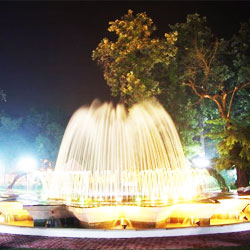
Introduction : The picturesque city of Kanpur is an important industrial center of Uttar Pradesh. The city is located on the banks of the river Ganga. Kanpur is the mecca for visitors who are interested in historical and religious places and monuments. There are thousands of tourists from every corner of the world who come to visit Kanpur every year. There are a number of eye catching places to look for in Kanpur. The tourist spots in Kanpur include Shri Radhakrishna Temple (J.K.Temple), Jain Glass Temple, Kanpur Memorial Church, Allen Forset Zoo, Jajmau, Nana Rao Park, Phool Bagh, Buddha Park, Moti Jheel Park, Kamla Retreat just to name a few. Amongst all these parks and tourist attraction spots the one that stands tall is the Phool Bagh, Kanpur. Phool Bagh, Kanpur is also known as 'Ganesh Udyan'. Phool Bagh is one of the most beautiful and exquisite parks which is situated in the heart of the picturesque city of Kanpur on the Mall Road. Description : The Ganesh Shanker Vidyarthi Memorial, located in the center of Phool Bagh in Kanpur in India, is usually used for the purpose pf public meetings. The flower shows that are organized locally every year are held here. The Phool Bagh, Uttar Pradesh possesses a large Public library and a Summer House. Phool Bagh is an extremely well maintained and well cared for park with various varieties of rare plants and trees. Phool Bagh, Kanpur is the perfect destination for any family outing as the Bagh provides the visitors with a serene and peaceful feeling.
Explore More
Maharaja Ranjit Singh built this small palace and park in 1819. It lies in the newer, northern part of Amritsar. It used to serve as a summer residence for the philanthropic, one-eyed Maharaja (who rebuilt the Golden Temple) between 1818 and 1837 and now houses the Ranjit Singh museum, which has paintings and weapons dating back to the Mughal period. This beautiful garden is named as a tribute to Guru Ram Das, the founder of the city The museum contains weapons dating back to Mughal times and some portraits of the ruling houses of the Punjab and a replica of the diamond.
Explore More
Located at Jogeshwari, a fun park enveloped in 30 acres of lush green landscape Fantasy Land provides many entertainment rides for those with appetite for adventurous rides. It is another amusement park made up of modern mechanism games for children and adults like Essel World. It is also a venue for fun and games for visitors of all ages. Fantasy Land, a fun park within the city limits of Mumbai, The park opened to the public in September 1992 and has since grown from strength to strength adding new innovative entertainment and sporting attractions that have been one of their kind in India.
Explore More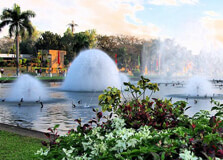
Rizal Park is a historical urban park. It is reckoned as the Asia’s largest urban park and also called Luneta Park. The park is situated along Roxas Boulevard, City of Manila, Philippines. It can be located adjacent to Intramuros. The park is visited by many on weekends and national holidays. History The land on which the park is straddled was the location of a town called Nuevo Barrio. During 1762 to 1764, the town was ruined by British, and the location came to be known as Bagumbayan Field. In 1995, Luneta was declared a national park after President Ramon Magsaysay signed Proclamation No. 234. Park Sections · Northeastern Section: It includes the 16-hectare (40-acre) Teodora F. Valencia Circle adjoining Taft Avenue. · Central Section: It is a 22-hectare (54-acre) park and extends down to Roxas Boulevard. · Southwestern Section: It comprises of Burnham Green, a 10-hectare (25-acre) open field, Manila Ocean Park along Manila Bay and the Quirino Grandstand. Recent Events in Park · In January 18 2015, the largest papal gathering was held here. · The Million People March was organized in the park in August 22–26, 2013. · Pentecostal Missionary Church of Christ (4th Watch) organized International Missionary Day at Quirino Grandstand in January 17, 2010 in the park.
Explore More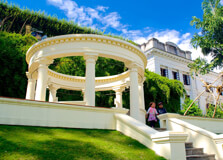
Located in the heart of Kathmandu, the Garden of Dreams (also known as the "Garden of Six Seasons") is an oasis of tranquility amidst the bustling city. Spread over an area of 6.5 acres, this beautifully restored historic garden is a testament to the beauty of nature and a great place to escape from the hustle and bustle of the capital. It is one of the most popular attractions in Kathmandu, not only for its beauty but also for its rich history and unique architecture. How to Reach Garden of Dreams, Kathmandu Getting to the Garden of Dreams is quite easy as it is located in the central part of Kathmandu, near the Kaiser Mahal area. The most common way to reach the garden is by taxi, which can be easily hailed from most parts of the city. If you're staying in the Thamel area, the garden is only a 10-minute walk away. Alternatively, you can opt for a local bus or use a rickshaw to get to the garden. Many visitors prefer walking as it offers a great opportunity to explore the vibrant streets of Kathmandu along the way. If you're traveling by private vehicle, parking is available near the entrance of the garden. Weather The climate in Kathmandu is mild and pleasant throughout most of the year. The best time to visit the Garden of Dreams is during the spring (March to May) and autumn (September to November) seasons, when the weather is clear, and the temperatures are comfortable. During these seasons, the garden is in full bloom, and visitors can enjoy the serene atmosphere. Summer months (June to August) can be hot and humid with occasional monsoon rains, which may cause some inconvenience for outdoor activities. Winters (December to February) are cool, with temperatures dipping to around 5-10°C, but it's still a great time to enjoy the peaceful surroundings of the garden. Timings The Garden of Dreams is open every day of the week, typically from 9:00 AM to 9:00 PM. However, the timings may vary depending on the season and special events. It is advisable to check in advance before planning your visit. The garden's entrance closes at 8:00 PM, so visitors should arrive before that time to fully experience the beauty of the garden. Why Famous for Garden of Dreams, Kathmandu? The Garden of Dreams is famous for several reasons, primarily its historical significance and its lush, well-maintained landscape. The garden was originally built by Field Marshal Kaiser Sumsher Rana in the early 20th century as a private garden and entertainment space. The garden has been meticulously restored over the years, and it stands as a symbol of the elegance and grandeur of Nepal's past aristocracy. Another reason for its fame is the design and architecture. The garden is designed to represent the six seasons of Nepalese culture, with different sections of the garden reflecting different seasons, such as the Summer Garden, Monsoon Garden, and Winter Garden. The blend of European and Nepali architectural styles gives the garden a unique aesthetic appeal. Entry and Visit Details about Garden of Dreams, Kathmandu To enter the Garden of Dreams, visitors need to pay an entrance fee, which helps in the maintenance and preservation of the garden. The current entry fee is around NPR 200 for foreign tourists and NPR 50 for Nepali citizens. Children under 10 years of age can enter for free. The entry fee includes access to all the garden's main areas, including the beautiful pavilions, ponds, and fountains. For those who wish to relax and enjoy a drink or meal, the Kaiser Cafe, located inside the garden, offers a variety of beverages, snacks, and meals in a charming and serene environment. History and Architecture The Garden of Dreams was originally built in 1920 by Kaiser Sumsher Rana, a prominent figure of Nepal's Rana era. The garden was designed by the famous architect Edward M. McFarlane in collaboration with the Ranas' court architects. The idea was to create a peaceful retreat that would reflect the glory and splendor of the royal family. The garden features a combination of European and Nepali architectural styles, with elements like marble sculptures, ornate fountains, and intricate pavilions. Sadly, after the fall of the Rana regime in the mid-20th century, the garden fell into disrepair. However, in 2000, a significant restoration project was launched with the help of the Austrian government. The restoration effort focused on preserving the historical integrity of the garden while also making it accessible to the public as a cultural heritage site. Today, it stands as one of the most important landmarks in Kathmandu. Things to Do at Garden of Dreams, Kathmandu Visitors to the Garden of Dreams can enjoy a variety of activities. The most common activity is simply strolling around the beautifully landscaped grounds, taking in the fresh air, and relaxing by the fountains. The lush greenery, tranquil ponds, and artistic pavilions provide a peaceful escape from the busy streets of Kathmandu. For photography enthusiasts, the garden offers ample opportunities to capture stunning photos of the architecture, flora, and fauna. The garden is also a great place for a picnic or a leisurely afternoon tea at the Kaiser Cafe. Additionally, there are cultural events and exhibitions held from time to time, which add an extra layer of excitement and engagement for visitors. Facts and Tips about Garden of Dreams, Kathmandu The Garden of Dreams is one of the oldest gardens in Kathmandu and a symbol of Nepal's rich history and culture. The garden is home to a variety of exotic plants, including rare species of flowers and trees, which makes it a paradise for nature lovers. If you're planning to visit, wear comfortable shoes as you'll be walking on uneven paths and gravel. Don't forget to bring your camera – the garden's architecture and landscape are ideal for photography. If you're looking for a quiet place to read or meditate, this is the perfect spot. The peaceful environment encourages relaxation and reflection. Try to visit during the morning or late afternoon when the weather is cooler and the light is perfect for photography. Conclusion The Garden of Dreams in Kathmandu is a must-visit destination for those seeking peace, beauty, and a glimpse into the history of Nepal. Whether you're a history buff, an architecture enthusiast, or simply someone looking for a serene escape, the garden offers something for everyone. Its historical significance, architectural beauty, and tranquil ambiance make it one of the most cherished landmarks in Kathmandu. So, if you're planning a trip to Nepal, make sure to include the Garden of Dreams in your itinerary for an unforgettable experience.
Explore More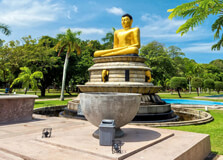
Viharamahadevi Park, located in the heart of Colombo, Sri Lanka, is the city’s largest and most popular public park. This lush green space is a tranquil escape from the hustle and bustle of city life, offering locals and tourists a peaceful environment to relax, unwind, and enjoy nature. Named after the mother of King Dutugemunu, one of Sri Lanka’s greatest ancient kings, the park is a key landmark in Colombo, combining historical significance, recreational opportunities, and scenic beauty. Whether you want to take a leisurely stroll, enjoy a picnic, or simply soak in the natural surroundings, Viharamahadevi Park is an essential destination for anyone visiting the city. How to Reach Viharamahadevi Park Viharamahadevi Park is centrally located in Colombo, making it easily accessible by various means of transportation. Here are some options to reach the park: By Car/Taxi: The easiest and most convenient way to reach the park is by taxi or private car. It is located on the city’s main road, just behind the Colombo Town Hall. The park is approximately a 5-minute drive from the Colombo Fort area. By Bus: Public buses in Colombo connect various parts of the city, and you can reach Viharamahadevi Park by taking a bus that stops at the nearby Town Hall. From there, it’s just a short walk to the park. By Train: The nearest railway station to Viharamahadevi Park is Colombo Fort Railway Station, about 2 km away. From the station, you can either take a short tuk-tuk ride or walk to the park. Weather in Colombo Colombo experiences a tropical climate with warm temperatures throughout the year. The average temperature typically ranges from 26°C (79°F) to 31°C (88°F). The city also experiences two monsoon seasons: the southwest monsoon, which occurs between May and September, and the northeast monsoon from December to February. The best time to visit Viharamahadevi Park is during the dry months of December to March, when the weather is more pleasant and less humid. If you visit during the rainy season, it's advisable to bring an umbrella or raincoat. It’s also a good idea to wear light, breathable clothing, sunscreen, and a hat, especially during the hotter months, as the sun can be intense. Why Famous for Viharamahadevi Park Viharamahadevi Park is famous for several reasons. Not only is it the oldest and largest public park in Colombo, but it also holds cultural and historical importance. The park was originally known as "Victoria Park" in honor of Queen Victoria during British colonial rule, but it was later renamed after Queen Viharamahadevi, the mother of King Dutugemunu, who played a significant role in Sri Lanka’s ancient history. The park’s location, right in the center of Colombo, makes it a peaceful oasis in the middle of the city’s busy streets. It is a popular spot for both locals and tourists who come to relax, enjoy a leisurely walk, or participate in various recreational activities. The park features beautiful landscaping, wide green lawns, serene ponds, and a variety of trees and plants, offering an inviting atmosphere for families, joggers, and nature lovers. In addition to its natural beauty, the park is also home to several important landmarks and statues, including a statue of Queen Victoria. Its central location makes it an excellent spot to relax after visiting nearby attractions such as the Colombo National Museum and the Town Hall. Entry and Visit Details About Viharamahadevi Park Visiting Viharamahadevi Park is a refreshing experience, and there are a few important details to keep in mind when planning your visit: Opening Hours: Viharamahadevi Park is open every day from 5:00 AM to 9:00 PM. The park is accessible throughout the day, and visitors can enjoy a leisurely visit during both the day and evening hours. Entry Fee: Entry to Viharamahadevi Park is free. It is a public park, and there are no charges for admission. However, donations are appreciated to help maintain the park's beauty and facilities. Facilities: The park is equipped with basic facilities, including public restrooms, seating areas, and shaded spots perfect for picnics. It also has a children’s playground, making it an ideal family-friendly location. A walking track is available for those who want to jog or take a brisk walk around the park. History and Architecture of Viharamahadevi Park The history of Viharamahadevi Park dates back to the late 19th century when it was originally laid out by the British colonial government. The park was initially named "Victoria Park" in honor of Queen Victoria, reflecting the colonial influence of the time. It was later renamed to honor Queen Viharamahadevi, the mother of King Dutugemunu, who is remembered for her significant contribution to the Buddhist religion and Sri Lankan history. The park is an excellent example of British colonial-era landscaping, with wide-open spaces, manicured lawns, and tree-lined walkways. Over time, the park has undergone several renovations and expansions to enhance its facilities and keep it in good condition. Today, the park is a fine blend of colonial architecture, traditional Sri Lankan landscaping, and modern amenities. The central feature of the park is the large, open lawn, which serves as a space for relaxation, sports activities, and family outings. The park also contains several ponds and fountains, providing both aesthetic appeal and a tranquil environment for visitors. The lush greenery of the park offers a refreshing contrast to the busy urban landscape that surrounds it. Things to Do at Viharamahadevi Park Viharamahadevi Park is a versatile destination, offering a variety of activities for visitors of all ages. Here are some of the top things to do at the park: Relax and Unwind: Whether you’re visiting alone or with family and friends, Viharamahadevi Park is the perfect place to relax and enjoy nature. Find a quiet spot under a tree, read a book, or simply sit by the ponds and enjoy the peaceful surroundings. Take a Leisurely Walk: The park offers well-maintained walking paths and shaded areas where you can take a leisurely walk or jog. The large green lawns make it a great place for a peaceful stroll. Enjoy a Picnic: The park is a great spot for a picnic, especially in the shaded areas. Bring your own food or snacks and enjoy a meal while surrounded by nature. Children’s Playground: If you’re visiting with young children, the park features a children's playground equipped with swings and slides, providing entertainment for the little ones. Photography: The park offers beautiful photo opportunities, with its lush greenery, tranquil ponds, and historical statues, including the statue of Queen Victoria. The peaceful environment also makes it an ideal spot for nature photography. Facts About Viharamahadevi Park The park was originally named "Victoria Park" in honor of Queen Victoria, but was later renamed in honor of Queen Viharamahadevi, the mother of King Dutugemunu. It covers an area of around 30 acres and is the largest public park in Colombo. Viharamahadevi Park is home to several ponds, fountains, and a large variety of trees and plants, making it a great place for nature lovers and photographers. The park is located behind the Colombo Town Hall, making it an easily accessible spot for visitors exploring the city. Tips for Visiting Viharamahadevi Park Best Time to Visit: The best time to visit the park is in the early morning or late afternoon when the weather is cooler and the park is less crowded. Stay Hydrated: The weather in Colombo can be hot, so it’s important to carry a bottle of water, especially if you plan to walk or engage in outdoor activities. Respect the Environment: As a public park, it’s important to maintain cleanliness. Dispose of trash in the provided bins and be mindful of others who are enjoying the space. Combine with Other Attractions: After visiting Viharamahadevi Park, you can explore nearby attractions such as the Colombo National Museum or the nearby Town Hall.
Explore More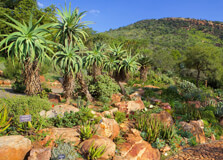
Walter Sisulu National Botanical Gardens
The Walter Sisulu National Botanical Gardens is one of South Africa's most picturesque natural attractions. Located in Roodepoort, on the western outskirts of Johannesburg, this garden spans over 300 hectares and is a haven for nature enthusiasts, families, hikers, and bird watchers. Managed by the South African National Biodiversity Institute (SANBI), the garden was named in honor of anti-apartheid activist Walter Sisulu and is known for its stunning combination of indigenous flora, geological features, and the iconic Witpoortjie Waterfall. How to Reach Walter Sisulu National Botanical Gardens, Gauteng Reaching the Walter Sisulu Botanical Gardens is convenient for both locals and tourists: By Car: Located just 30 km from Johannesburg city center, it takes about 30 to 45 minutes by car via the N1 and Hendrik Potgieter Road. Ample parking is available on-site. By Public Transport: While limited, minibus taxis and ride-hailing services like Uber or Bolt are available from Johannesburg and nearby areas. From O.R. Tambo International Airport: The garden is about a 1-hour drive. Visitors can use shuttle services or rent a car to get there comfortably. Weather at Walter Sisulu National Botanical Gardens, Gauteng Gauteng experiences a subtropical highland climate, making outdoor visits to the gardens enjoyable most of the year: Summer (October to March): Warm and rainy, with average temperatures ranging from 18°C to 30°C. Afternoon showers are common, so bring an umbrella or raincoat. Winter (May to August): Dry and cool with clear skies. Daytime temperatures are pleasant (15°C to 22°C), though mornings and evenings can be chilly. The gardens are especially lush and green during summer, but winter is ideal for hiking and birdwatching due to reduced foliage. Timings The Walter Sisulu National Botanical Gardens operates daily, with specific timings: Opening Hours: 8:00 AM to 5:00 PM (last entry at 4:00 PM) Closed: Only on Christmas Day and Good Friday Why Famous for Walter Sisulu National Botanical Gardens, Gauteng? The gardens are famous for being one of the most beautiful botanical gardens in South Africa. They showcase more than 600 plant species native to the region and are home to the iconic Witpoortjie Waterfall, which cascades down a rock face surrounded by natural cliffs and bushveld. Another notable highlight is the pair of Verreaux’s Eagles (Black Eagles) that have nested on the cliffs above the waterfall for decades—making it a unique birdwatching spot. Besides their natural appeal, the gardens also honor Walter Sisulu’s legacy as a national hero and feature educational, ecological, and recreational spaces that promote biodiversity conservation. Entry and Visit Details about Walter Sisulu National Botanical Gardens, Gauteng Visitors can enjoy easy access to the garden, which is well-managed and offers excellent amenities: Entry Fee: Adults: R70 Students and Pensioners: R40 Children (6-18 years): R20 Children under 6: Free Facilities: Restrooms, picnic areas, a restaurant, wheelchair-accessible paths, gift shops, and guided tours. Guided Tours: Educational tours available by prior arrangement for schools and tour groups. History and Architecture The garden was officially established in 1982 but the area has been a popular nature destination for much longer. It was renamed in 2004 to honor Walter Sisulu, who was a prominent freedom fighter and political leader in South Africa. The garden doesn’t feature classical architectural structures but is designed with careful landscaping that integrates natural rock formations, streams, and terraces into the environment. Stone pathways, wooden bridges, and small gazebos are scattered throughout, blending naturally with the terrain. Things to Do at Walter Sisulu National Botanical Gardens, Gauteng Hiking and Walking Trails: Several self-guided trails range from easy walks to moderate hikes, including the Geological Trail and Roodekrans Ridge. Birdwatching: Over 220 bird species, with special attention on the nesting Black Eagles, make this a top birding destination. Photography: Ideal for landscape, nature, and wildlife photography, especially near the waterfall. Picnicking: Shaded lawns and designated picnic spots are perfect for family outings. Botanical Education: Learn about indigenous plants and conservation through labeled species, workshops, and educational signs. Events: The gardens occasionally host concerts, yoga sessions, and eco-friendly events in the amphitheater. Facts about Walter Sisulu National Botanical Gardens, Gauteng The garden is one of 11 national botanical gardens in South Africa managed by SANBI. Home to the only known pair of Black Eagles nesting in an urban environment. Includes a succulent rockery, fern trail, and cycad garden among its curated plant collections. Spans over 300 hectares, although a portion is kept as conservation wilderness area not open to the public. Recognized as one of the most family-friendly botanical gardens in the country. Tips about Walter Sisulu National Botanical Gardens, Gauteng Visit early in the morning for cooler weather and birdwatching opportunities. Wear comfortable walking shoes and bring a hat, sunscreen, and water bottle. Stay on marked trails to protect the flora and for your own safety. No alcohol or pets (except guide dogs) are allowed in the gardens. Binoculars and cameras are highly recommended for wildlife and scenic views. Check for live events or temporary exhibits before your visit via SANBI's website or the garden’s official social media pages.
Explore More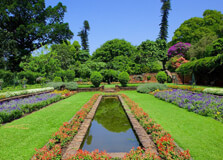
The Durban Botanical Gardens, located in the heart of Durban, South Africa, stands as a testament to horticultural excellence and natural beauty. Established in 1849, it is Africa's oldest surviving botanical garden and a cherished green space for both locals and tourists. Spanning approximately 15 hectares, the gardens boast an impressive collection of indigenous and exotic plants, offering a tranquil oasis amidst the bustling city. From rare orchids and cycads to vibrant floral displays and serene water features, the Durban Botanical Gardens provide a captivating experience for nature lovers, researchers, and anyone seeking a peaceful escape. How to reach Durban Botanical Gardens, Durban The Durban Botanical Gardens are centrally located and easily accessible by various means of transport: By Car: If you are driving, the gardens are situated off Botanic Gardens Road in the Berea area. From the city center, follow signs towards Berea. Ample parking is available outside the gardens, although it can get busy on weekends and public holidays. By Taxi or Ride-sharing Services: Taxis and ride-sharing services like Uber and Bolt are readily available throughout Durban and offer a convenient way to reach the gardens. Simply provide "Durban Botanical Gardens" as your destination. By Public Transport: Durban's public bus system has routes that pass near the Botanical Gardens. You can check the local bus schedules for the most convenient options from your location. By Walking: If you are staying in the Berea area or nearby, the gardens might be within walking distance. It's a pleasant stroll through residential streets leading to the green expanse of the gardens. Weather in Durban Durban enjoys a subtropical climate with warm, humid summers and mild, dry winters. During the summer months (December to February), average high temperatures hover around 30°C, accompanied by high humidity and occasional rainfall, often in the form of afternoon thunderstorms. The winter months (June to August) are generally sunny and pleasant, with average daytime temperatures around 23°C. Evenings can be cooler during winter. When visiting the Durban Botanical Gardens, it's advisable to check the weather forecast. During summer, wear light, breathable clothing, sunscreen, and a hat. In winter, layering might be necessary. Be prepared for potential rain, especially during the summer months. Timing The Durban Botanical Gardens are generally open to the public throughout the year. While specific opening and closing times might vary, they typically operate during daylight hours. It's recommended to check the official website of the Durban Botanical Gardens or the eThekwini Municipality for the most accurate and up-to-date information on operating hours before planning your visit. This will ensure you have ample time to explore all the different sections of the gardens. They are usually open seven days a week, making it a flexible destination for visitors. Why famous for Durban Botanical Gardens, Durban? The Durban Botanical Gardens are famous for several compelling reasons: Historical Significance: As Africa's oldest surviving botanical garden, it holds significant historical and cultural value. Diverse Plant Collections: The gardens boast an impressive collection of indigenous and exotic plants from around the world, including rare and endangered species. Orchid House: The Orchid House is a major attraction, showcasing a stunning variety of orchids in a controlled environment. Cycad Collection: The gardens are home to a remarkable collection of cycads, some of which are ancient and highly endangered. Herbarium: The gardens house a significant herbarium, which is a collection of preserved plant specimens used for scientific research. Tranquil Atmosphere: The gardens offer a peaceful and serene environment, providing a welcome escape from the urban hustle and bustle. Educational Opportunities: The gardens serve as an educational resource, offering insights into botany, horticulture, and conservation. Beautiful Landscaping: The carefully designed landscapes, water features, and themed gardens create a visually appealing and relaxing space. Entry and visit details about Durban Botanical Gardens, Durban The Durban Botanical Gardens are generally free to enter, making it an accessible attraction for everyone. However, there might be charges for specific events or guided tours. When visiting, it's important to respect the gardens and its collections: Entry Fee: Typically, there is no general entrance fee to explore the Durban Botanical Gardens. Guided Tours: Guided tours might be available for a fee, offering in-depth information about the gardens' history, collections, and specific plant species. Check with the gardens' administration for availability and pricing. Photography: Photography is usually permitted for personal use, but commercial photography or filming might require prior permission. Picnics: Visitors are generally welcome to enjoy picnics in designated areas of the gardens. Remember to clean up after yourself and dispose of waste responsibly. Respect the Plants: Please refrain from picking flowers, damaging plants, or climbing on structures. Accessibility: The gardens are largely accessible, with pathways suitable for wheelchairs and strollers in many areas. However, some sections might have uneven terrain. History The Durban Botanical Gardens were established in 1849 by the Durban Agricultural and Horticultural Society. Initially, the gardens served as a testing ground for agricultural crops and were instrumental in introducing various plants to the region, including sugarcane. Over time, the focus shifted towards botanical collections and ornamental horticulture. The gardens have played a significant role in the scientific understanding and conservation of plant life in the region. Throughout their history, they have undergone various developments and expansions, evolving into the diverse and beautiful space they are today, surviving numerous challenges and remaining a vital part of Durban's heritage. Architecture While the Durban Botanical Gardens are primarily focused on plant life, there are some notable architectural elements within the grounds that contribute to their charm and functionality: The Orchid House: This glasshouse provides a controlled environment for the delicate orchid collection and features a Victorian-style design. The Tea Garden Building: The tea garden often has a building with a distinct architectural style, providing a place for visitors to relax and enjoy refreshments. The Herbarium Building: This building houses the preserved plant specimens and is designed to maintain the integrity of the collection. Water Features and Structures: Bridges, ponds, and other water features are integrated into the landscape, adding to the aesthetic appeal and often designed with natural materials. Benches and Shelters: Strategically placed benches and shelters offer visitors বিশ্রাম spots and protection from the elements. The overall architectural style tends to be functional and harmonious with the natural surroundings, emphasizing the beauty of the plant collections. Things to do There are numerous engaging activities to enjoy at the Durban Botanical Gardens: Explore the Plant Collections: Wander through the various themed gardens, including the cycad collection, orchid house, succulent collection, and indigenous plant displays. Enjoy a Picnic: Find a scenic spot to relax and enjoy a picnic amidst the greenery. Go Bird Watching: The gardens attract a variety of bird species, making it a pleasant spot for bird enthusiasts. Take a Guided Tour: Learn more about the gardens' history and plant collections by joining a guided tour. Attend Events and Workshops: Check the gardens' schedule for horticultural workshops, concerts, and other events. Visit the Tea Garden: Enjoy refreshments and light meals at the tea garden. Photography: Capture the beauty of the flowers, plants, and landscapes with your camera. Relax and Reflect: Find a quiet bench to sit and enjoy the peaceful atmosphere. Learn at the Herbarium: While access might be restricted, understanding the role of the herbarium in plant science can be insightful. Facts about Durban Botanical Gardens, Durban Established in 1849, it is the oldest surviving botanical garden in Africa. The gardens span approximately 15 hectares. It houses a significant collection of indigenous and exotic plants. The Orchid House showcases a stunning variety of orchids. The gardens have an impressive collection of cycads, some of which are very old. It is home to a valuable herbarium used for botanical research. Entry to the gardens is generally free. The gardens have played a role in the introduction of various plants to South Africa. It is a popular spot for picnics, bird watching, and leisurely walks. Tips about Durban Botanical Gardens, Durban Wear comfortable walking shoes as you'll be exploring a large area. Bring water, especially on hot days. Apply sunscreen and wear a hat to protect yourself from the sun. Consider visiting during different seasons to see a variety of plants in bloom. Check the gardens' website for information on special events or workshops. Bring your camera to capture the beautiful flora and landscapes. Be respectful of the plants and avoid picking or damaging them. Utilize the benches and shaded areas for rest. Clean up after yourself if you have a picnic. Take your time to explore the different sections of the gardens. Consider joining a guided tour for a more in-depth experience.
Explore More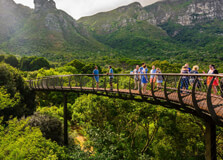
Kirstenbosch Botanical Gardens
Kirstenbosch National Botanical Gardens is one of the most celebrated botanical gardens in the world. Nestled on the eastern slopes of Table Mountain, this garden is a haven for nature lovers, photographers, and anyone who appreciates the beauty of indigenous plants. Spanning over 500 hectares, it is renowned for its diverse collection of South African flora, its stunning views of Table Mountain, and its rich cultural and historical significance. It is one of the most popular attractions in Cape Town, offering visitors a peaceful escape while showcasing the natural beauty of the region. Why is Kirstenbosch Famous? Kirstenbosch is famous for being one of the most beautiful botanical gardens globally, not only for its lush greenery and scenic vistas but also for its dedication to preserving South Africa’s rich plant life. It is the only botanical garden in the world that is located within a UNESCO World Heritage Site, the Cape Floristic Region, which is known for its unique plant species. Kirstenbosch is especially well-known for its collection of indigenous plants, including the stunning proteas, fynbos, and a wide variety of other species found only in South Africa. Another reason for Kirstenbosch's fame is its stunning setting. With Table Mountain towering above the garden and the vast landscapes of the Cape Peninsula stretching below, the views are truly spectacular. Visitors also enjoy Kirstenbosch’s well-maintained walking trails, picnic spots, and the famous tree canopy walkway, also known as the "Boomslang" (Tree Snake), which allows visitors to walk above the trees for an elevated view of the garden. How to Reach Kirstenbosch National Botanical Gardens, Cape Town Kirstenbosch is located on the eastern slopes of Table Mountain in Cape Town, making it easily accessible from the city center. There are several ways to get to the garden: By Car If you're driving, Kirstenbosch is located approximately 13 kilometers (8 miles) from the Cape Town city center. You can take the M63 (Rhodes Drive) and follow the signs to Kirstenbosch. The garden has ample parking, though it can get crowded during peak seasons, so it’s a good idea to arrive early to secure a spot. By Public Transport Public transport options to Kirstenbosch are limited, but you can use Cape Town's MyCiTi bus service, which has routes that pass through the nearby area. The closest bus stop is at the University of Cape Town (UCT) and is a short walk from the garden entrance. By Taxi or Ride-sharing Taxis and ride-sharing services like Uber are popular in Cape Town and can take you directly to the garden’s entrance. This is a convenient option if you're not driving yourself. Weather at Kirstenbosch National Botanical Gardens The climate in Cape Town is Mediterranean, with warm, dry summers and cool, wet winters. Kirstenbosch enjoys a temperate climate, making it a pleasant destination year-round. In the summer months (from November to February), temperatures can range from 18°C to 26°C (64°F to 79°F). Winters (from June to August) are mild, with temperatures typically ranging from 7°C to 18°C (45°F to 64°F). Rainfall is more common during the winter months, so it’s wise to check the weather forecast before visiting. Summer evenings can be quite chilly, especially if you're planning to visit in the late afternoon, so bringing a light jacket is a good idea. The gardens are lush and vibrant throughout the year, but visiting during spring (September to November) or summer will give you a chance to witness the flora in full bloom. Timing and Opening Hours Kirstenbosch is open every day of the year, and its opening hours are as follows: Summer (November to March): 8:00 AM – 7:00 PM Winter (April to October): 8:00 AM – 6:00 PM Last entry is typically about 30 minutes before closing time. The garden is open on public holidays, though special events and concerts may have different hours. Entry and Visit Details Entry to Kirstenbosch is not free, but the entry fee is very reasonable. Visitors can purchase tickets at the entrance or online through the official website to avoid waiting in line. The ticket prices are as follows: Adults: 75 ZAR Seniors (over 60 years): 65 ZAR Children (under 18): Free (with accompanying adults) Students: 40 ZAR It is advisable to visit the garden in the morning or early afternoon, as it can get busy, especially during peak tourist seasons. You can also combine a visit to Kirstenbosch with a trip to Table Mountain, as both attractions are nearby. History and Architecture Kirstenbosch was established in 1913 by the South African botanist Percy Fox and the South African government to conserve the country's unique indigenous plants. The garden’s creation was the result of growing concerns over the destruction of local plant life due to urbanization and agriculture. Today, the garden spans 528 hectares and is home to over 7,000 plant species, the majority of which are native to South Africa. The architecture of Kirstenbosch is minimal and designed to blend seamlessly with the natural environment. The most famous structure in the garden is the "Boomslang" (Tree Snake) canopy walkway, a tree-top platform that offers visitors a unique view of the garden. The walkway is suspended in the trees and provides panoramic views of the garden and the surrounding landscape. The garden also has well-maintained paths and terraces that allow visitors to explore different sections of the park easily. Things to Do at Kirstenbosch National Botanical Gardens While Kirstenbosch is mainly known for its botanical beauty, there are several things to do and experience during your visit: 1. Explore the Gardens Take your time to explore the vast variety of plants, ranging from delicate fynbos to towering proteas. Kirstenbosch is divided into different sections based on plant types, such as the Cycad Garden, Medicinal Garden, and Fragrance Garden, where you can explore indigenous South African flora in a carefully curated setting. 2. Visit the Tree Canopy Walkway (Boomslang) The Boomslang canopy walkway is one of Kirstenbosch’s most famous features. This elevated walkway winds through the trees and offers a bird’s-eye view of the garden and the surrounding landscape. It’s a unique experience that’s not to be missed! 3. Picnic in the Gardens Kirstenbosch is a perfect spot for a picnic. The gardens are equipped with well-maintained lawns where visitors can enjoy a relaxed meal surrounded by natural beauty. There are also a few designated picnic areas where you can spread out and enjoy a peaceful afternoon. 4. Attend a Summer Sunset Concert During the summer months, Kirstenbosch hosts popular outdoor sunset concerts. These concerts feature a variety of local and international musicians and are a great way to spend an evening in the garden. It’s advisable to purchase tickets in advance as they can sell out quickly. Facts About Kirstenbosch National Botanical Gardens Kirstenbosch is one of the oldest botanical gardens in Africa and is part of the Cape Floral Kingdom. The garden spans over 500 hectares, of which 36 hectares are cultivated for the public to explore. The “Boomslang” canopy walkway is a 130-meter-long elevated walkway that offers sweeping views of the garden and Table Mountain. Kirstenbosch is home to the famous protea, South Africa's national flower. Tips for Visiting Kirstenbosch National Botanical Gardens Wear comfortable shoes: If you plan to explore the garden's trails, wear comfortable walking shoes, as the terrain can be uneven in certain areas. Check the weather: The garden is best visited on clear days, especially if you plan to hike or visit the canopy walkway. Check the weather forecast before you go. Bring a picnic: Kirstenbosch is a wonderful place for a picnic, so pack some food and enjoy the peaceful surroundings. Arrive early: The gardens can get crowded during peak hours, so try to arrive early to avoid large crowds. Conclusion Kirstenbosch National Botanical Gardens is a must-visit destination in Cape Town, offering visitors a stunning collection of South African plants, beautiful views of Table Mountain, and a peaceful atmosphere. Whether you're a nature enthusiast, a photographer, or someone simply looking for a relaxing day in the outdoors, Kirstenbosch has something for everyone. With its rich history, beautiful landscapes, and various activities, a visit to Kirstenbosch is sure to be a highlight of any trip to Cape Town.
Explore More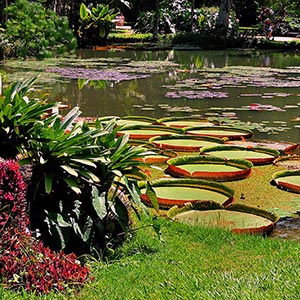
Jardim Botânico, also known as the Rio de Janeiro Botanical Garden, is one of Brazil’s most beautiful and important green spaces. Located at the foot of Corcovado Mountain and near the famous Christ the Redeemer statue, this lush botanical garden is a serene escape from the bustling city. Established in 1808 by King João VI of Portugal, it spans over 137 hectares and houses more than 6,500 species of plants, many of which are rare or endangered. The garden is both a scientific research center and a public park that attracts nature lovers, photographers, tourists, and researchers alike. How to Reach Jardim Botânico, Rio de Janeiro Jardim Botânico is situated in the South Zone of Rio de Janeiro and is easily accessible by public and private transport. The garden is located near the neighborhoods of Lagoa, Gávea, and Ipanema. You can take a city bus to the Jardim Botânico neighborhood—several routes stop near the entrance. Alternatively, taxis, ride-sharing apps like Uber or 99, or private vehicles are convenient and relatively inexpensive options. The nearest metro station is in Ipanema (General Osório), and from there, you can catch a bus or taxi to the garden. Weather in Jardim Botânico Rio de Janeiro has a tropical climate, and the Jardim Botânico area is no exception. Temperatures remain warm year-round, typically ranging from 22°C to 33°C (72°F to 91°F). Humidity levels are often high, especially during the summer months from December to March. Rain is common in the summer, while the drier months, from May to September, offer the best weather for a comfortable stroll through the garden. Morning visits are ideal, as the temperatures are cooler and the light is perfect for photography. Timing and Visiting Hours Jardim Botânico is open to visitors Tuesday through Sunday from 8:00 AM to 5:00 PM. It is closed on Mondays for maintenance, except when it falls on a public holiday. It is recommended to arrive early in the day to enjoy the garden in cooler weather and avoid the afternoon crowds. The entire garden can take 2 to 3 hours to explore leisurely. Why is Jardim Botânico Famous? Jardim Botânico is renowned for its diverse collection of tropical and subtropical plant species from around the world. It is especially famous for its majestic avenue of royal palm trees (Palmeiras Imperiais), some of which date back over 200 years. The garden is also home to a stunning collection of orchids, bromeliads, and carnivorous plants. In addition to its botanical treasures, the garden is a haven for wildlife, including monkeys, toucans, and capybaras. Its peaceful setting and scenic beauty make it a favorite spot for weddings, film shoots, and nature photography. Furthermore, the Jardim Botânico Research Institute contributes significantly to scientific research, conservation, and education about Brazil’s flora. Entry and Visit Details Admission to Jardim Botânico is reasonably priced. As of recent updates, tickets cost around R$ 30 (Brazilian Real) for foreign visitors, with discounts available for students, seniors, and locals. Tickets can be purchased at the entrance or online. Guided tours in English and Portuguese are available for those interested in a deeper understanding of the flora and history of the garden. There are also restrooms, drinking fountains, a visitor center, and a café within the garden. Visitors should follow park rules, such as staying on marked paths, not picking plants, and maintaining a respectful noise level to preserve the tranquility and ecological balance of the garden. History and Architecture Jardim Botânico was founded in 1808 by King João VI of Portugal as a way to acclimatize spices like nutmeg, pepper, and cinnamon from the East Indies to the Brazilian climate. Over the centuries, the garden transformed from a royal plantation into a public scientific and educational institution. Architecturally, the garden features several historical buildings, including the Research Institute building, colonial-style greenhouses, and the Casa dos Pilões, which once housed a gunpowder factory. The central avenue lined with soaring royal palms is one of the garden’s most iconic features and a legacy of its imperial origins. Things to Do in Jardim Botânico Jardim Botânico offers a variety of enriching experiences for visitors: Explore Themed Gardens: Discover Japanese gardens, medicinal plant areas, and cactus gardens. Orchid and Bromeliad Houses: Admire rare and exotic species housed in beautifully maintained greenhouses. Bird and Wildlife Watching: Keep an eye out for monkeys, squirrels, toucans, and even small lizards. Visit the Sensory Garden: Designed for the visually impaired, this garden allows visitors to touch and smell different plant species. Photography and Art: The garden is a perfect location for photography, painting, or simply relaxing with a book or sketchpad. Educational Trails: Several marked paths provide detailed information about native Brazilian ecosystems. Facts and Tips about Jardim Botânico, Rio de Janeiro Interesting Facts: Jardim Botânico is home to over 6,500 species of plants and trees, many of which are endangered or rare. It was designated a UNESCO Biosphere Reserve due to its ecological importance. Several of the original palm trees were planted in 1809 and still stand tall today. The garden was used as a filming location for international movies and Brazilian soap operas. Travel Tips: Bring insect repellent and sunscreen, especially in summer months. Wear comfortable walking shoes—some paths are cobblestone or unpaved. Carry a water bottle; although fountains are available, staying hydrated is important. Plan to spend 2 to 3 hours if you want to explore most sections of the garden leisurely. If you’re a nature lover, consider combining your visit with the nearby Parque Lage or a hike up to Corcovado. Jardim Botânico is more than just a park—it's a living museum of tropical biodiversity and an oasis of calm in the heart of Rio de Janeiro. Whether you're a botanist, a birdwatcher, a photographer, or a curious traveler, a visit here promises education, relaxation, and inspiration in equal measure.
Explore More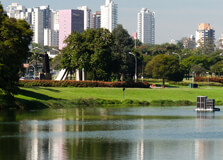
Ibirapuera Park (Parque Ibirapuera) is one of the most famous and iconic urban parks in Brazil. Located in the heart of São Paulo, it is a vast green area that combines nature, culture, and leisure in one place. Spanning over 158 hectares (391 acres), it is often compared to Central Park in New York City due to its significance to urban life and its popularity among locals and tourists alike. The park is a favorite spot for walking, jogging, biking, sightseeing, and attending cultural events. How to Reach Ibirapuera Park, São Paulo Ibirapuera Park is located in the Vila Mariana district of São Paulo, making it accessible from many parts of the city. You can reach the park easily by several modes of transport: Metro: The nearest metro stations are Brigadeiro (Line 2 - Green), Paraíso, and AACD-Servidor. From there, you can walk or take a short taxi or bus ride. Bus: Multiple city buses stop near the entrances of the park. Check local bus schedules using Google Maps or the SPTrans app. Taxi/Ride-Sharing: Uber, 99, and other ride-sharing services are widely used in São Paulo and are a convenient option to reach the park directly. Car: There is parking available near some of the park entrances, although it can get crowded on weekends and holidays. Weather in Ibirapuera Park São Paulo has a humid subtropical climate. Weather at Ibirapuera Park is typically mild and pleasant for outdoor activities: Summer (December–March): Warm and humid with average temperatures between 20°C and 30°C (68°F to 86°F). Rainfall is common during this season. Winter (June–August): Cooler and drier, with temperatures between 12°C and 24°C (54°F to 75°F). The best time to visit is in the morning or late afternoon when the temperatures are cooler and the lighting is ideal for photos. Avoid visiting during midday in summer to escape the heat. Timing and Visiting Hours Ibirapuera Park is open daily from 5:00 AM to midnight. Certain buildings and attractions within the park have their own specific operating hours, usually from 9:00 AM to 5:00 PM or later, depending on exhibitions or events. The park is busiest on weekends and holidays, while weekdays offer a quieter experience. Early mornings are ideal for joggers and nature enthusiasts, while evenings attract families and cultural visitors. Why is Ibirapuera Park Famous? Ibirapuera Park is famous for its unique combination of green spaces, museums, and iconic architecture. It was designed by renowned Brazilian landscape architect Roberto Burle Marx, and its buildings were created by legendary architect Oscar Niemeyer. The park is not only a recreational space but also a cultural hub. It is home to several major museums and exhibition spaces, including the São Paulo Museum of Modern Art (MAM), Oca exhibition pavilion, Afro Brazil Museum, and the Ibirapuera Auditorium. It also hosts concerts, public events, and annual celebrations like São Paulo’s anniversary and national holidays. Entry and Visit Details Entry to Ibirapuera Park is free of charge. You can freely walk, cycle, or jog through the park without any cost. However, entrance fees may apply for specific cultural venues within the park: Afro Brazil Museum: Charges a modest entrance fee, with discounts for students and seniors. MAM (Museum of Modern Art): Ticketed entry depending on exhibitions; often offers free entry on certain days. Ibirapuera Auditorium: Free or ticketed depending on the event or performance schedule. You’ll find restrooms, drinking fountains, food vendors, and bicycle rental kiosks throughout the park. It’s a safe and well-maintained environment, ideal for families, solo visitors, and tourists. History and Architecture Ibirapuera Park was officially opened in 1954 to commemorate the 400th anniversary of the founding of São Paulo. The park was part of a major urban development initiative and remains one of the city's most important achievements in combining public recreation with cultural heritage. The park's layout was designed by landscape architect Roberto Burle Marx, while Oscar Niemeyer created its distinctive buildings with modernist curves and open-air concepts. One of the most iconic structures is the Oca Pavilion, known for its dome shape, which hosts temporary exhibitions and cultural events. Another notable structure is the Ibirapuera Auditorium, a red-canopied concert hall that stands out for its architectural beauty and acoustics. Things to Do in Ibirapuera Park There are numerous activities and attractions for all types of visitors: Jogging and Biking: Several designated paths for cyclists and runners wind through lush greenery. Picnicking and Relaxing: Open lawns and shaded areas are perfect for relaxing, reading, or having a picnic. Visit Museums: Explore Brazilian art and history at MAM and the Afro Brazil Museum. Attend Concerts: Enjoy performances at the Ibirapuera Auditorium, especially during weekends. Explore Architecture: Walk around and admire Niemeyer’s modernist structures. Family Activities: Playgrounds and interactive spaces are available for children. Photography and Birdwatching: Great spot for scenic photos and observing native birds and wildlife. Facts and Tips about Ibirapuera Park, São Paulo Interesting Facts: The name “Ibirapuera” comes from the Tupi language and means “rotten wood” or “old tree.” It is the second-largest park in São Paulo, after Parque do Carmo. The park attracts over 14 million visitors annually. It was voted one of the best urban parks in the world by The Guardian and other travel platforms. Travel Tips: Arrive early in the morning for a peaceful experience and cooler weather. Wear comfortable walking shoes and bring sunscreen, especially on sunny days. If you want to explore museums, check online for exhibition schedules and ticket prices in advance. Bring a picnic mat or blanket if you plan to relax on the grass. Use bicycles to cover more ground—rental stations are available inside the park. Keep an eye on local event calendars—there are often free concerts and exhibitions. Ibirapuera Park is more than just a city park; it’s a place where nature, art, history, and recreation come together beautifully. Whether you’re a tourist, a culture lover, or someone simply looking to enjoy nature in an urban setting, Ibirapuera Park offers an unforgettable experience right in the heart of São Paulo.
Explore More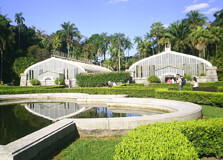
The Jardim Botânico de São Paulo (São Paulo Botanical Garden) is one of the most beautiful and serene green spaces in Brazil’s largest city. Located in the southern region of São Paulo, this vast garden covers over 360,000 square meters and is home to an incredible variety of native Brazilian flora and fauna. It serves as a scientific, educational, and recreational space that offers visitors an opportunity to relax in nature while learning about biodiversity and conservation. Its tranquil atmosphere, scenic lakes, greenhouses, orchid gardens, and historical buildings make it a must-visit destination for both tourists and locals. How to Reach Jardim Botânico de São Paulo, São Paulo The garden is situated in the Água Funda neighborhood, close to major transportation routes. By Car: You can easily reach the garden via Avenida Miguel Estéfano. Parking is available on-site for a reasonable fee. By Metro: Take Line 1 (Blue) to São Judas or Conceição station. From there, take a bus or taxi to the garden. By Bus: Several public buses pass through Avenida Miguel Estéfano. Look for buses heading to Zoo Safari or Zoológico, which are nearby landmarks. By Taxi or Ride-Sharing: Services like Uber and 99 are readily available and convenient, especially from central São Paulo or metro stations. Weather in Jardim Botânico de São Paulo Area São Paulo has a subtropical climate with distinct seasons: Summer (December to March): Warm and humid with temperatures ranging from 22°C to 30°C (72°F to 86°F), and occasional afternoon showers. Winter (June to August): Mild and dry with average temperatures between 12°C and 22°C (54°F to 72°F). Spring and Autumn: Pleasant temperatures and fewer crowds make these ideal times to visit. It is advisable to bring a hat, sunscreen, and water when visiting during hot months and a light jacket in cooler seasons. Timing and Best Time to Visit Jardim Botânico de São Paulo The Botanical Garden operates from Tuesday to Sunday. Opening Hours: 9:00 AM to 5:00 PM Closed on: Mondays, except on national holidays The best time to visit is during the morning hours to enjoy cooler temperatures and vibrant bird activity. Weekdays are less crowded, offering a more peaceful experience. Spring is particularly lovely due to blooming orchids and flowering trees. Why Famous for Jardim Botânico de São Paulo, São Paulo? Jardim Botânico de São Paulo is celebrated for its environmental and educational importance, as well as its scenic beauty. Rich Biodiversity: Home to hundreds of plant species, many of which are native or endangered. Scientific Research: Operated by the Instituto de Botânica, the garden plays a key role in research and conservation. Orchidarium: One of the highlights, showcasing various species of orchids in a stunning environment. Historic Greenhouses: 20th-century architectural gems that house tropical and aquatic plants. Natural Beauty: Tranquil lakes, walking trails, and picnic areas surrounded by Atlantic Forest remnants. Entry and Visit Details about Jardim Botânico de São Paulo, São Paulo Entry to the Botanical Garden requires a ticket. General Admission: Around R$ 15 for adults (subject to change) Discounted Tickets: Available for students, seniors, and children Free Entry: Children under 4, seniors over 60, and on certain public holidays Tickets can be purchased at the entrance or online. Guided tours are occasionally available, particularly for school groups and educational institutions. Amenities include: Clean restrooms Drinking water fountains Picnic areas Small café and snack bars Souvenir and plant shops History and Architecture of Jardim Botânico de São Paulo The Jardim Botânico was officially opened in 1928 by the botanist Frederico Carlos Hoehne. It was created as part of the Institute of Botany to support research and botanical education in Brazil. Initially serving academic purposes, it gradually became a public attraction. Architecturally, the garden blends classical design with natural forest surroundings. Two elegant greenhouses, inspired by European botanical architecture, were built to protect and display plant species. A colonial-style building houses administrative offices and exhibition spaces. Wooden walkways and bridges over the lakes add rustic charm, while observation decks offer scenic views. Things to Do at Jardim Botânico de São Paulo There are plenty of enriching activities to do at the garden: Explore the Orchidarium: Admire rare and colorful orchid species in a controlled environment. Visit the Greenhouses: Discover tropical and aquatic plants carefully curated by botanists. Walk the Trails: Follow trails through native forest areas and learn about native plants. Birdwatching: Spot toucans, hummingbirds, and other native species. Photography: Capture beautiful plant life, lakes, and scenic landscapes. Picnicking: Enjoy a meal with family or friends in shaded, grassy areas. Educational Displays: Learn from plant labels, interpretive panels, and periodic exhibitions. Facts and Tips about Jardim Botânico de São Paulo, São Paulo Interesting Facts: The garden spans over 36 hectares and is part of the Atlantic Forest biome. It supports scientific studies in botany, ecology, and conservation. The main lake was once a source for the Ipiranga River. It has over 1,200 species of plants, some extremely rare or endangered. The area includes preserved forest trails used for environmental education. Visitor Tips: Wear comfortable shoes for walking on natural trails and uneven paths. Bring insect repellent and sunscreen, especially in summer. Respect nature—do not touch or remove any plants. Food is allowed only in designated picnic areas. Photography is allowed, but drones are prohibited without permission. Check the official website or call ahead for holiday hours and any temporary closures. In summary, the Jardim Botânico de São Paulo is a peaceful, educational, and environmentally rich destination perfect for nature lovers, students, and families. It offers a break from city life, allowing visitors to immerse themselves in Brazil’s natural heritage while enjoying the serenity of carefully cultivated gardens and native forests.
Explore More
Located on the stunning **Hon Tre Island**, Vinpearl Land Amusement Park in **Nha Trang, Vietnam**, is a world-class entertainment complex that attracts visitors from all over the world. Often referred to as the "Disneyland of Vietnam," it offers a mix of **thrilling rides, a water park, a massive aquarium, and cultural shows**. With its beautiful beaches and luxurious resorts, it is the perfect place for families, couples, and adventure seekers. How to Reach Vinpearl Land Amusement Park, Nha Trang Vinpearl Land is situated on **Hon Tre Island**, which is easily accessible from Nha Trang. Here’s how you can get there: By Cable Car: The **Vinpearl Cable Car** is a **3.3 km long** ride offering spectacular views of Nha Trang Bay. It takes about **12 minutes** to reach the park. By Speedboat: Several speedboats run from **Cau Da Port** in Nha Trang to Hon Tre Island, taking about **7-10 minutes**. By Ferry: A slower and more budget-friendly option, the ferry takes about **20 minutes**. By Private Yacht: For a luxury experience, private yacht transfers are available. Weather in Nha Trang Vinpearl Land experiences warm and tropical weather throughout the year: Best Time to Visit: **January to August** when temperatures are **25-32°C** with minimal rainfall. Rainy Season: **September to December** sees occasional rain and slightly cooler temperatures. Vinpearl Land Amusement Park Timing The park is open daily from 8:30 AM to 9:00 PM. The best time to visit is early in the morning to enjoy all the attractions before it gets crowded. Why is Vinpearl Land Amusement Park Famous? Vinpearl Land is famous for its **world-class attractions** and entertainment options, including: The Longest Overwater Cable Car: A **stunning ride** that connects Nha Trang to Hon Tre Island. Exciting Roller Coasters & Rides: Featuring thrilling attractions for all age groups. Massive Water Park: One of the **biggest water parks in Vietnam** with slides and wave pools. Aquarium: Home to over **300 species of marine life**. Luxury Resorts & Beaches: A combination of fun and relaxation in one place. Entry and Visit Details Entry Fee: Approx. **VND 880,000 - 1,200,000** per person (varies by season and ticket type). Best Time to Visit: Weekdays to avoid heavy crowds. Duration of Visit: **Full day (6-8 hours)** to explore all attractions. History and Architecture Vinpearl Land was developed by **Vingroup**, one of Vietnam’s largest corporations. It was designed to be a **luxury entertainment destination**, combining modern amusement park features with traditional Vietnamese elements. Things to Do at Vinpearl Land Ride the Cable Car: Enjoy breathtaking aerial views of Nha Trang Bay. Experience Thrill Rides: Try **roller coasters, bumper cars, and the drop tower**. Visit the Aquarium: A **spectacular underwater tunnel** showcasing exotic marine life. Relax at the Water Park: Enjoy **wave pools, lazy rivers, and extreme slides**. Watch Cultural Shows: Enjoy **Vietnamese traditional dance performances**. Explore the Food Village: Taste delicious **Vietnamese and international cuisine**. Facts About Vinpearl Land Amusement Park The **Vinpearl Cable Car** is the **longest overwater cable car** in the world. The park covers an area of over **200,000 square meters**. It was officially opened in **2007** and has expanded over the years. The **aquarium houses over 300 species** of marine life, making it one of Vietnam’s largest. The **park’s water slides are among the tallest in Southeast Asia**. Tips for Visiting Vinpearl Land Arrive Early: To make the most of your time, **reach before 9:00 AM**. Wear Comfortable Clothes: Bring swimwear for the **water park** and comfortable shoes for walking. Stay Hydrated: The park is huge, so carry water bottles. Plan Your Day: Prioritize rides and attractions to avoid long queues. Use Lockers: Keep your valuables safe by renting a locker. Check Show Timings: Don’t miss out on the **laser light show and cultural performances**.
Explore More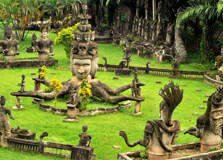
Buddha Park (also known as Xieng Khuan) is one of the most fascinating and unique attractions in Vientiane, Laos. This open-air sculpture park is located around 25 kilometers southeast of the capital and is home to over 200 Buddhist and Hindu statues. The park is famous for its surreal atmosphere and intricate artwork, which blends Buddhist, Hindu, and Lao traditions. The sight of massive statues, many of them grotesque and bizarre, offers a truly one-of-a-kind experience for visitors. How to Reach Buddha Park, Vientiane Buddha Park is located in a rural area just outside Vientiane, making it a perfect day-trip destination. Here’s how to reach it: By Tuk-Tuk: The most common way to reach Buddha Park from Vientiane is by tuk-tuk. Many tuk-tuk drivers offer round-trip services, making it convenient for visitors. The ride typically takes around 30 to 40 minutes one way. By Minibus: Minibuses are available from the central bus station in Vientiane. They run at regular intervals and are an affordable way to get to the park. By Private Taxi: For those who prefer more comfort and privacy, hiring a taxi is an excellent option. Many taxis offer round-trip services to and from the park. By Motorbike: For more adventurous travelers, renting a motorbike is a great option. The park is about a 30-minute ride from the city center. Weather and Timing Vientiane has a tropical climate, which means the weather can significantly impact your visit to Buddha Park. Here's what you can expect: Dry Season (November to April): This is the best time to visit Buddha Park, with temperatures ranging from 25°C to 35°C (77°F to 95°F). The skies are clear, and rainfall is minimal, making for ideal sightseeing conditions. Wet Season (May to October): The wet season brings more humidity and frequent rain, especially in the afternoons. While the park remains open during this period, the heavy rainfall can make some areas muddy and slippery. You may still enjoy the park, but it’s advisable to bring an umbrella and waterproof footwear. Timing of Visit Buddha Park is open every day from 8:00 AM to 5:00 PM. The best times to visit are in the early morning or late afternoon when the temperatures are cooler, and the light is better for photography. The park can get crowded during peak hours, so visiting early will allow you to enjoy a quieter, more peaceful experience. Why Buddha Park is Famous Buddha Park has gained widespread fame for several unique reasons: Unique Sculptures: The park is home to over 200 statues, each portraying a different figure from Buddhist and Hindu mythology. The sculptures range from serene and graceful to strange and grotesque, creating an otherworldly atmosphere. The Giant Reclining Buddha: One of the park’s most famous features is the enormous reclining Buddha statue, which measures more than 40 meters in length. This sculpture attracts photographers and visitors from around the world. Spiritual Significance: While the park's aesthetic appeal is undeniable, the sculptures also have deep religious significance. They are meant to convey important lessons from Buddhism and Hinduism, including the concept of heaven, hell, and reincarnation. Entry and Visit Details about Buddha Park The entrance fee to Buddha Park is relatively affordable, costing around 5,000 Lao Kip (approximately $0.50 USD) for entry. This small fee helps in maintaining the park and its sculptures. Visitors can explore the park on foot, and there are plenty of shaded areas where you can rest while taking in the sculptures. The park is equipped with basic facilities such as bathrooms, snack vendors, and small shops selling souvenirs. The peaceful atmosphere is perfect for those looking to meditate or simply enjoy the natural beauty surrounding the sculptures. History and Architecture of Buddha Park Buddha Park was created in 1958 by Luang Pu Bunleua Sulilat, a Laotian shaman, and artist who sought to combine Buddhist and Hindu traditions in his art. He envisioned the park as a space where people could contemplate the themes of life, death, and rebirth. The architecture of Buddha Park is unique in that it blends elements of both Hinduism and Buddhism, with sculptures representing Hindu deities, Buddhist teachings, and figures from Lao folklore. The park is designed as a spiritual journey, with the giant sculptures symbolizing different stages of existence and the afterlife. The most famous structure is a giant concrete sphere that contains a small temple and offers visitors a chance to climb to the top for panoramic views of the surrounding area. Things to Do at Buddha Park Explore the Sculptures: Wander around the park and admire the intricate sculptures. Each one has its own story to tell, and many are truly unique and unexpected in their form. Climb the Giant Sphere: One of the most interesting features of Buddha Park is the giant concrete sphere. Visitors can climb to the top of the sphere, which offers stunning views of the surrounding landscape and the park itself. Visit the Reclining Buddha: The Reclining Buddha is one of the park's most famous statues. It’s an impressive sight and one of the main reasons many tourists come to Buddha Park. Photography: With its unique sculptures and beautiful surroundings, Buddha Park is a photographer’s dream. Bring your camera to capture the intricate details of the statues and the vast landscape. Learn the Symbolism: Take time to understand the religious and philosophical meanings behind the sculptures. Many visitors choose to hire a local guide to get a deeper understanding of the park’s spiritual significance. Facts and Tips about Buddha Park Bring Comfortable Shoes: Since the park covers a large area, it’s advisable to wear comfortable shoes for walking. You’ll likely do a fair bit of exploring on foot. Best Time to Visit: The best time to visit Buddha Park is during the dry season (November to April). The weather will be more pleasant, and you'll have better visibility for photographs. Respect the Site: Buddha Park is a sacred place for many, so be respectful when visiting. Avoid climbing on or touching the statues, as this can damage the artwork and show disrespect. Stay Hydrated: The park can get quite hot, especially during midday, so make sure to carry water with you to stay hydrated. Hire a Guide: Hiring a guide can enhance your visit by providing deeper insight into the meaning behind the sculptures and the history of Buddha Park.
Explore More
A beautifully well-laid compact garden with swimming pool and mausoleums of erstwhile rulers of Kapurthala is filled with piece and is a great spot for spending leisure time. The Shalimar Gardens where Maharaja Ranjit Singh and Maharaja Fateh Singh had met. There are also "Samadhis" of former rulers of Kapurthala State in this historic garden having excellent work on art of them. In addition have a pond, a park & a library. The Basant Panchi Mela is organized every year in this significant garden. The State Gurudwara located in the city centre, was built by Maharaja Jagatjit Singh.
Explore More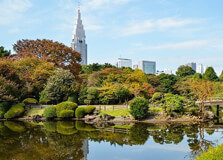
Shinjuku Gyoen is a large and scenic park located in the heart of Tokyo, Japan. It offers a tranquil escape from the hustle and bustle of the city, providing a peaceful environment for visitors to enjoy nature, stroll through beautiful gardens, and experience traditional Japanese landscaping. With its combination of traditional Japanese, English, and French garden styles, Shinjuku Gyoen is one of Tokyo’s most beloved public parks and a must-visit destination for nature lovers and tourists alike. How to Reach Shinjuku Gyoen, Tokyo Shinjuku Gyoen is easily accessible from various parts of Tokyo. Here’s how to get there: By Train: The park is conveniently located near Shinjuku Station, one of Tokyo’s busiest transport hubs. You can take the Tokyo Metro Marunouchi Line to Shinjuku Gyoemmae Station (about a 5-minute walk from the park entrance) or take the JR Chuo Line to Shinjuku Station and walk for about 10 minutes to the park. By Bus: There are multiple bus routes that pass by Shinjuku Gyoen. You can take the Toei Bus or the Keio Bus to get off at the “Shinjuku Gyoen” stop. By Taxi: Taxis are a convenient option, especially if you're traveling with a group or carrying heavy items. The park is easily accessible from most parts of Shinjuku and central Tokyo. Weather in Tokyo Tokyo experiences four distinct seasons, which means the weather in Shinjuku Gyoen changes throughout the year. Here's what to expect during each season: Spring (March to May): Spring in Tokyo is famous for its cherry blossoms. Shinjuku Gyoen is one of the best spots to view sakura (cherry blossoms), typically from late March to early April. The temperatures range from 10°C to 20°C (50°F to 68°F), making it a pleasant time to visit. Summer (June to August): Summer can be hot and humid in Tokyo, with temperatures reaching 30°C (86°F) or higher. However, the park’s lush greenery and shaded areas provide a cool escape from the heat. The rainy season typically starts in June and lasts for a few weeks. Autumn (September to November): Autumn is another beautiful time to visit Shinjuku Gyoen, as the park is known for its stunning fall foliage. The temperatures range from 15°C to 22°C (59°F to 72°F), creating a pleasant atmosphere for sightseeing. Winter (December to February): Winters in Tokyo are cold but not extreme, with temperatures ranging from 4°C to 10°C (39°F to 50°F). Winter is a quieter time in the park, offering a peaceful experience amidst the bare trees. Timing and Opening Hours Shinjuku Gyoen is open year-round, except on certain days like New Year’s Day. The opening hours are as follows: Opening Hours: 9:00 AM to 4:30 PM (last entry is at 4:00 PM). Closed: The park is closed on Mondays (unless it is a public holiday) and from December 29 to January 3 for maintenance and New Year’s holidays. Special Hours: During the cherry blossom season (usually late March to early April), the park may have extended hours to accommodate the influx of visitors. Why is Shinjuku Gyoen Famous? Shinjuku Gyoen is famous for its expansive green spaces, beautiful gardens, and serene atmosphere in the middle of one of Tokyo’s busiest districts. Here are some reasons why this park is so beloved: Cherry Blossoms: The park is one of the best spots in Tokyo for viewing sakura (cherry blossoms) during spring. The sight of thousands of blooming cherry trees is a significant draw for both locals and tourists. Garden Variety: Shinjuku Gyoen is unique because it features three different styles of gardens: a traditional Japanese landscape garden, a formal French garden, and an English-style garden, all of which offer diverse experiences and beautiful scenery throughout the year. Peaceful Retreat: Despite being located in the heart of the city, the park provides a peaceful, quiet environment where visitors can escape the city’s hustle and bustle. It is a popular spot for relaxation, picnics, and photography. Entry and Visit Details about Shinjuku Gyoen Shinjuku Gyoen is open to the public year-round, and it’s an affordable attraction to visit: Entry Fee: The entry fee for adults is ¥500. There are discounted rates for students (¥250) and free entry for children under 15 years old. Group Visits: Groups of 20 or more can receive discounted rates, so it’s a great option for school tours or group outings. Ticket Purchase: Tickets can be purchased at the entrance gates. The park has multiple entrances, so you can access the park from different sides depending on where you are coming from. History and Architecture of Shinjuku Gyoen Shinjuku Gyoen was originally created as a private garden for the Tokugawa family in the early 17th century. It was later transformed into a public park in 1949, after World War II. The park’s design incorporates elements from different periods and styles, reflecting both traditional Japanese landscaping and Western influences. The park’s architecture includes beautiful traditional teahouses, well-maintained walking paths, and several ponds, each offering a different view of the surroundings. The French-style garden features symmetrically designed flower beds, while the English garden offers a more relaxed and natural layout. Shinjuku Gyoen’s design beautifully merges natural landscapes with architectural elements, providing visitors with a holistic experience of Japan’s cultural and gardening history. Things to Do at Shinjuku Gyoen There are many things to do at Shinjuku Gyoen that cater to all types of visitors: Stroll Through the Gardens: Enjoy the peaceful atmosphere by taking a leisurely walk through the park’s three distinct gardens. Each garden offers a different experience and provides plenty of opportunities for photography. Cherry Blossom Viewing: If you visit during the sakura season, make sure to participate in hanami (cherry blossom viewing). It’s a wonderful tradition in Japan, where locals gather to enjoy picnics under the blooming cherry trees. Picnic and Relax: Shinjuku Gyoen is a perfect place to relax, have a picnic, or simply unwind. There are many spots where you can sit and enjoy the park's beauty. Visit the Teahouses: The park has several traditional Japanese teahouses where you can experience a Japanese tea ceremony or simply enjoy a cup of tea surrounded by the beauty of nature. Interesting Facts and Tips about Shinjuku Gyoen Spring and Autumn Peaks: The park is most famous during the spring cherry blossom season and autumn when the fall foliage is at its peak. Visiting during these times will give you the best experience. Photography: Shinjuku Gyoen is an excellent spot for photography, especially during the sakura season or when the leaves change color in autumn. Don’t forget to bring your camera! Quiet Escape: Despite being located in a busy area like Shinjuku, the park is remarkably peaceful, making it a great place to escape from the hustle and bustle of Tokyo. Early Morning Visit: For a quieter experience, visit the park early in the morning when there are fewer people, and you can enjoy the beauty of nature in peace. Conclusion Shinjuku Gyoen is a hidden gem in the heart of Tokyo, offering visitors a chance to experience the beauty of nature and traditional Japanese landscaping. Whether you’re visiting during the cherry blossom season, enjoying a peaceful walk in autumn, or simply looking for a quiet place to relax, this park provides an ideal escape from the busy city life. With its unique blend of Japanese, English, and French gardens, Shinjuku Gyoen is a must-visit for anyone traveling to Tokyo.
Explore More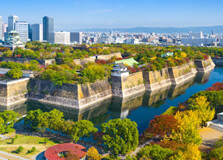
Osaka Castle Park (Osaka-jo Koen) is one of Japan's most iconic and historically significant landmarks, located in the heart of Osaka. It surrounds the famous Osaka Castle, a towering white structure originally built in the late 16th century by Toyotomi Hideyoshi, a prominent feudal lord and unifier of Japan. Spanning over 100 hectares, the park is not just a historical site but also a large urban green space filled with gardens, sports facilities, walking trails, and seasonal beauty such as cherry blossoms in spring. The contrast between ancient architecture and modern cityscape makes Osaka Castle Park a beloved cultural and recreational hub for both locals and tourists. How to Reach Osaka Castle Park, Osaka Osaka Castle Park is centrally located and very well connected by public transportation. The most convenient way to reach the park is via the JR Osaka Loop Line. Get off at Osakajokoen Station, which is just a few minutes’ walk from the park entrance. Alternatively, the park is accessible from Tanimachi 4-chome Station on the Tanimachi and Chuo subway lines or Morinomiya Station on the JR Loop Line and Chuo Line. From Osaka Station or Namba, it typically takes 15 to 25 minutes by train or subway. Weather Around Osaka Castle Park Osaka experiences a humid subtropical climate. Summers (June to August) are hot and humid, often exceeding 30°C. Winters (December to February) are mild with average temperatures around 5–10°C, making the park accessible year-round. Spring (March to May) is the most popular time to visit, especially during cherry blossom season in early April. Autumn (October to November) also brings pleasant weather and beautiful foliage. Visitors should dress according to the season and carry sun protection during summer or umbrellas during the rainy season in June. Timings Osaka Castle Park is open 24 hours a day and can be visited freely at any time. However, the Osaka Castle Main Tower (museum inside the castle) has specific operating hours: typically from 9:00 AM to 5:00 PM, with last admission at 4:30 PM. These timings may vary slightly on special occasions or holidays. Other facilities within the park, such as cafes or historical buildings, may also have their own schedules. Why Famous for Osaka Castle Park, Osaka? Osaka Castle Park is famous for being the home of Osaka Castle, one of Japan's most famous castles. The castle is symbolic of Japan's feudal history and was originally built in 1583 by Toyotomi Hideyoshi, a major figure in Japan’s unification. The park is equally renowned for its seasonal beauty, especially during the cherry blossom (sakura) season in spring and colorful foliage in autumn. Its blend of natural beauty, historical significance, and cultural landmarks makes it a top attraction in Osaka. The main tower offers panoramic views of the city and a museum showcasing artifacts from the feudal era. Entry and Visit Details Entry to Osaka Castle Park itself is free. Visitors can freely explore the grounds, gardens, and open spaces. However, to enter the Osaka Castle Main Tower Museum, tickets are required: Adults: 600 yen Children under 15: Free Tickets can be purchased at the entrance or online. Group discounts are available, and the castle accepts both cash and cashless payments. Guided tours, audio guides, and information panels in multiple languages are available for those interested in the historical context. History and Architecture Osaka Castle was originally constructed in 1583 by Toyotomi Hideyoshi as a symbol of his power and as a stronghold for unifying Japan. It was built on the site of the former Ishiyama Hongan-ji Temple, which had been destroyed by Oda Nobunaga. After Hideyoshi’s death, the castle was destroyed and rebuilt multiple times. The current main tower, which was reconstructed in 1931 and renovated in the 1990s, is a ferroconcrete building that houses a museum. Despite the modern structure, the castle retains its traditional design with white walls, green-tiled roofs, and gold leaf decorations. The surrounding moats, stone walls, and gates reflect classic Japanese castle architecture. Things to Do at Osaka Castle Park There’s plenty to see and do at Osaka Castle Park: Visit the Main Castle Tower: Explore the museum inside and enjoy panoramic views from the top floor. Stroll through Nishinomaru Garden: A peaceful area with over 600 cherry trees and a teahouse, ideal during cherry blossom season. Explore Historical Structures: See the massive stone walls, moats, and gates like Otemon Gate and Sakura-mon Gate. Enjoy Seasonal Events: The park hosts festivals, light-ups, and cultural events throughout the year. Relax and Picnic: The spacious lawns and scenic views make it a great spot for picnics and outdoor activities. Boat Rides: Try the Gozabune boat ride through the inner moat to enjoy the view from the water. Interesting Facts about Osaka Castle Park Osaka Castle was once the largest castle in Japan when first built by Toyotomi Hideyoshi. The castle has survived several reconstructions due to war, lightning, and fire. The outer walls were built using stones weighing up to 100 tons, brought from distant provinces. Over 3,000 cherry trees bloom in the park every spring, drawing thousands of visitors. The current main tower is one of the few castles in Japan with an elevator, making it accessible to all visitors. Tips for Visiting Osaka Castle Park Visit early in the morning or late afternoon to avoid crowds and enjoy cooler temperatures. If visiting in spring or autumn, bring a camera to capture the seasonal beauty. Wear comfortable shoes as the park is large and involves a lot of walking. Check the official website for information on exhibitions and seasonal events before visiting. Stop by the nearby Osaka Museum of History for a deeper understanding of the city's past. Consider combining your trip with a visit to nearby attractions like the Umeda Sky Building or Dotonbori district. Osaka Castle Park is a place where history, nature, and modern life coexist beautifully. Whether you're interested in samurai-era Japan, enjoy scenic walks, or want to experience cherry blossoms in full bloom, this park offers something for everyone. It stands not just as a monument of Osaka’s rich past, but also as a vital part of its urban culture today.
Explore More
Tennoji Park is one of the most beloved green spaces in Osaka, Japan. Located in the heart of the Tennoji district, this park combines nature, culture, and recreation in a beautifully landscaped setting. Spanning over 28 hectares, Tennoji Park is home to popular attractions such as the Tennoji Zoo, Osaka City Museum of Fine Arts, Keitakuen Garden, and scenic walkways filled with seasonal flowers. The park offers a peaceful retreat from the city's hustle and bustle while still being conveniently located in a busy urban area. Whether you're a family with kids, a solo traveler, or a nature lover, Tennoji Park is a must-visit destination when in Osaka. How to Reach Tennoji Park, Osaka Reaching Tennoji Park is very easy due to its central location and excellent public transportation connectivity. The park is directly accessible from Tennoji Station, one of Osaka’s major railway hubs. Tennoji Station is served by the JR Osaka Loop Line, the Midosuji Subway Line, the Tanimachi Subway Line, and Kintetsu Line. From the station, it’s just a short walk to the park's entrance. The park is also close to Shin-Imamiya Station and Dobutsuen-mae Station, making it reachable from other parts of the city within 10 to 20 minutes. Weather in Tennoji Park Area Osaka has a humid subtropical climate, which means the weather is generally warm and suitable for outdoor visits most of the year. Spring (March to May) brings pleasant temperatures and blooming flowers, making it an ideal time to stroll through Tennoji Park. Summer (June to August) is hot and humid, so it's best to visit early in the morning or later in the evening. Autumn (September to November) is comfortable and beautiful, especially when the park's trees change colors. Winter (December to February) is mild and dry, and the park remains open for exploration. Rain can occur throughout the year, so it’s advisable to carry an umbrella during your visit. Timings Tennoji Park is generally open daily from 9:30 AM to 5:00 PM. However, some facilities within the park, such as the zoo and museum, have their own hours and might close earlier. It’s best to check the official websites of specific attractions before visiting. The outdoor areas and general walking paths of the park may be accessible earlier and later in the day, even if indoor facilities are closed. Why Famous for Tennoji Park, Osaka? Tennoji Park is famous for its rich blend of nature, art, and culture. It's particularly known for the Tennoji Zoo, which has been entertaining and educating visitors since 1915. Another highlight is the Osaka City Museum of Fine Arts, which houses an impressive collection of Japanese and East Asian art. The traditional Keitakuen Garden offers a tranquil Japanese landscape garden experience. The park is also known for its seasonal flower displays, especially cherry blossoms in spring. In recent years, the addition of new green spaces and modern art installations has further enhanced its popularity. Entry and Visit Details about Tennoji Park, Osaka Entry to Tennoji Park itself is free, making it a budget-friendly option for visitors. However, separate admission fees apply for individual attractions within the park: Tennoji Zoo: Around 500 yen for adults, 200 yen for children Osaka City Museum of Fine Arts: Varies by exhibition (typically 300–800 yen) Keitakuen Garden: Around 150 yen Tickets can be purchased at the respective entrances. The park is stroller and wheelchair friendly, with clean restrooms, vending machines, and shaded seating areas. There are also cafés and food stalls for snacks and refreshments. History and Architecture Tennoji Park was established in 1909 during the Meiji period as part of Osaka's modernization efforts. It was designed as a Western-style public park to promote leisure and culture among the city’s residents. Over the years, it expanded to include the Tennoji Zoo and several cultural facilities. The architecture within the park reflects a combination of modern Japanese and traditional designs. For example, the Keitakuen Garden was designed in the traditional sukiya style, showcasing stone lanterns, koi ponds, and teahouses. Meanwhile, the Osaka City Museum of Fine Arts occupies a historic building that dates back to 1936 and features Western-style architecture with Japanese artistic elements. Things to Do at Tennoji Park, Osaka Tennoji Park offers a wide range of activities and experiences: Visit the Tennoji Zoo: Home to over 1,000 animals, including lions, elephants, and koalas. Explore Keitakuen Garden: A serene Japanese garden perfect for photography and quiet contemplation. Tour the Osaka City Museum of Fine Arts: Admire beautiful art exhibits from Japan and beyond. Relax on the lawns: The park has large grassy areas where you can picnic, play, or just unwind. Photography and Nature Walks: Seasonal flowers like tulips, roses, and cherry blossoms attract nature lovers and photographers. Play Areas for Children: There are multiple playgrounds designed for kids of different ages. Enjoy Local Events: Cultural and seasonal festivals are occasionally hosted in the park grounds. Facts about Tennoji Park, Osaka The zoo inside Tennoji Park is one of the oldest in Japan, opened in 1915. Keitakuen Garden was donated by the Sumitomo family and is now a symbol of classical Japanese gardening. The park is located next to Tsutenkaku Tower and Shinsekai district, making it easy to combine visits. In spring, the cherry blossoms attract hundreds of hanami (flower viewing) visitors daily. The entire park area covers more than 280,000 square meters. Tips for Visiting Tennoji Park, Osaka Plan at least 2–3 hours to fully enjoy the zoo, museum, and garden. Visit during spring or autumn for the best weather and scenery. Bring your own picnic or snacks if you plan to spend the afternoon relaxing in the park. Early mornings are quieter and better for photography or peaceful walks. Combine your visit with nearby attractions like Abeno Harukas, Shinsekai, or Spa World. Wear comfortable shoes as the park is large and includes a lot of walking. Check event schedules online to catch live performances or seasonal festivals. Tennoji Park is a perfect example of how urban spaces can provide beauty, education, and recreation in one location. Its accessibility, diverse attractions, and scenic charm make it a favorite spot for locals and tourists alike. Whether you’re visiting for the animals, art, gardens, or simply to relax, Tennoji Park offers a memorable experience in the heart of Osaka.
Explore More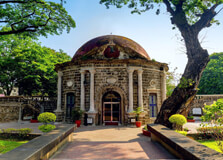
Paco Park stretches upto an area of 4,114.80 m2 (44,291.3 sq ft). It is a recreational garden area and situated in General Luna St. It is precisely located at the east end of Padre Faura Street in Paco district in the City of Manila, the Philippines. If one turns the pages of history, it can be found that Paco Park was once a Manila’s municipal cemetery. It is said that it was constructed by the Dominicans. History Paco Park was initially designed as a municipal cemetery for the rich and aristocratic Spanish families living in old Manila. The park was also used by Japanese forces in the second world war as central supply and ammunition depot. In the year 1966, the park was turned into National Park. Architecture Paco Park is expounded by circular shape. It has an inner circular fort, which is referred to as the original cemetery. The walls were contrived to be hollow, so that these could easily serve the purpose of niches. Later, the second outer wall was also built. For making promenades, the top of the walls were turned into pathways. The inside of the walls also has domed Roman Catholic chapel. It is small in size and dedicated to St. Pancratius.
Explore More